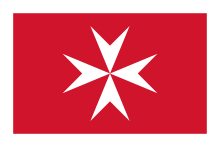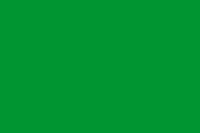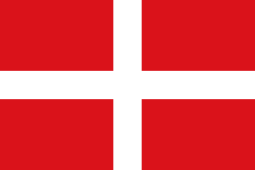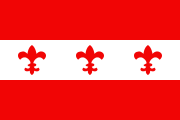List of flags of Malta
The following is a list of flags of Malta.
| Wikimedia Commons has media related to Flags of Malta. |
National flags
| Flag | Date | Use | Description |
|---|---|---|---|
 | 1964—Present | State flag and naval ensign | White and red, augmented in the canton by a depiction of the British George Cross. Ratio 2:3. |
 | 1964—Present | Civil ensign | Red, bordered white and charged with a white Maltese cross. Ratio 2:3. |
Governmental flags
| Flag | Date | Use | Description |
|---|---|---|---|
 | 1988—Present | Presidential standard | Blue, with the arms of Malta in the centre and a golden Maltese cross in each corner. Ratio: 2:3. |
| 1814—Present | Commissioner of the Police Force | Blue triangular pennant with a silver representation of the Malta Police badge in the centre. | |
 | 754—Present | Archbishop's standard | A papal flag (two equal vertical stripes, yellow and white), but with the ratio: 2:3. |
Military flags
| Flag | Date | Use | Description |
|---|---|---|---|
 | 1964—Present | Military ensign | Identical to the State flag. White and red, augmented in the canton by a depiction of the British George Cross. Ratio 2:3. |
 | 1964—Present | Naval jack | A George Cross proper fimbriated in red in the centre of a white square, within a red square. Each corner of the red square shall contain a white Maltese Cross. Ratio: 1:1. |
| c.1973—Present | Commander of the Armed Forces' Pennant | A red triangular pennant with golden emblem of the Armed Forces. The emblem is a mason tower of de Redin, which represents fortification and Malta defences back to the time of the knights of St. John. |
Historical flags
| Flag | Date | Use | Description |
|---|---|---|---|
 | 870–909 | Flag of the Abbasid Caliphate used in Malta | Undefaced black banner. |
 | 909–1091 | Flag of the Fatimid Caliphate used in Malta | Undefaced green banner. |
.svg.png) | 1091–1943 | Malta Civil Flag (Unofficial) | Undefaced white-red vertical bicolor. Ratio 2:3. |
 | 1530–1798 | Flag of the Order of Saint John | Red rectangular flag quartered by a white cross. |
 | 1798–1800 | Flag of France used in Malta | A vertical tricolour of blue, white, and red. |
.svg.png) | 1798–1813 | Flag of Sicily used in Malta | A white flag with the coat of arms of Sicily |
.svg.png) | 1798–1801 | Flag of Great Britain used in Malta | A superimposition of the flags of England and Scotland. |
 | 1801 onwards | Flag of Great Britain and Ireland used in Malta | A superimposition of the flags of England and Scotland with the Saint Patrick's Saltire (representing Ireland). |
 | 19th century | British Malta State ensign | Red Ensign with a white St George's cross, but no badge. |
.svg.png) | 1875–c.1898 | British Malta State ensign | Blue ensign. Badge: A white Maltese cross on white and red panel framed with ginger-bread. |
.svg.png) | c.1898–1923 | British Malta State ensgin | Blue ensign. Badge: On a white circle a white and red shield with pointed top and gold border. |
.svg.png) | 1923–1943 | British Malta State ensign | Blue ensign. Badge: White and red shield with pointed top and gold border. |
.svg.png) | 1943–1964 | British Malta State ensign | Blue ensign. Badge: On a white circle a white and red flat top shield with George Cross on blue canton. |
.svg.png) | 1943–1964 | Malta Civil Flag (Unofficial) | White-red vertical bicolor with George Cross on blue canton. |
.svg.png) | 1967–1974 | Queen Elizabeth II's Personal Flag for Malta | One of Queen Elizabeth II's personal flags. This flag was used to represent her as Queen of Malta until it was made redundant by the introduction of a republican form of government in 1974.
It featured the arms of Malta in banner form defaced with the device from her Personal Flag: a blue roundel with a crowned "E" surrounded by a wreath of gold roses.[1] Ratio 2:3. |
.svg.png) | 1875-c. 1898 | Governor's Flag | Badge: A white Maltese cross on white and red panel framed with ginger-bread, on a white circle surrounded by a garland on the Union Flag. |
.svg.png) | c.1898–1943 | Governor's Flag | Badge: White and red shield with pointed top and gold border, on a white circle surrounded by a garland on the Union Flag. |
.svg.png) | 1943–1964 | Governor's Flag | On a white circle surrounded by a garland on the Union Flag of the Governor. |
 | 1964–1974 | Governor-General's Flag | Commonwealth blue with the Royal Crest and Malta scroll. |
Local Councils
Some flags had been used prior to the creation of local councils in 1993. The coats of arms of the local councils are officially recognised, however the flags are not and thus a number of variants exist. Since 1993, a new local council, Mtarfa, has been created, and the local councils of Attard, Birżebbuġa, Floriana, Kalkara, Lija, Mellieħa, Mġarr, Mosta, Nadur, Naxxar, Paola, Qrendi, Siġġiewi, Xgħajra and Żebbuġ have changed their flags and coats of arms. Some, such as Mosta, had minor differences, but others, like Xgħajra changed the arms completely.
Malta
| Flag | Date | Use | Description |
|---|---|---|---|
 | 2000—Present | Attard (village) | A blue cross that represents Roman Catholicism and St. Mary with a red square in the middle on white background.
Current flag adopted in 2000, previous flag was similar but with white central square. |
 | 1993—Present | Balzan (village) | A red horizontal line between two some horizontal green lines, on white background. |
 | 1993—Present | Birgu - Città Vittoriosa (city) | Sword held upright and laurel are symbolizing the winner, olive probably the peace afterwards. A number of variants of the flag are known to exist. |
 | 1993—Present | Birkirkara (town) | Horizontally divided red over white, the top (red) stripe about half as wide as the bottom (white) one. A royal crown centred on the red stripe, a red Greek cross centred on the white stripe. |
 | 2000—Present | Birżebbuġa (village) | An olive plant representing this locality, and the colour blue because it is near the sea.
Current flag adopted in 2000, previous flag was dark blue with a yellow chain in orle and two yellow crossed keys in the centre. |
 | 1993—Present | Bormla - Città Cospicua (city) | A cotton plant on a yellow background. |
 | 1993—Present | Dingli (village) | Segmented diagonally in four triangles: two light blue facing each other horizontally and two red ones facing each other vertically, all separated with a white band. |
 | 1993—Present | Fgura (town) | A white flag with a red horizontal line, and three gold stars on the line. Similar to the flag of Kerċem. |
 | 2006—Present | Furjana (town) | Red rampant lion on a white background, taken from the coat of arms of Grandmaster António Manoel de Vilhena.
Current flag adopted in 2006, previous flag was divided per pale. The dexter side showed a red rampant lion with a golden head in a white field. The sinister side showed a golden winged arm holding upright a sword in natural colour. It was based on the coat of arms of the same Grandmaster. A variant of this flag also existed. |
 | 1993—Present | Gudja (village) | White flag with a red pointed bar. |
 | 1993—Present | Gżira (town) | A blue flag with a white wavy stripe from the top hoist to the bottom fly; on the top fly, a yellow heraldic ship, on the bottom hoist a yellow heraldic dolphin with a red tongue. |
 | 1993—Present | Għargħur (village) | A white flag with a red triangle from the bottom and a red star on top. |
 | 1993—Present | Għaxaq (village) | White flag defaced by three green bars. |
 | 1993—Present | Ħamrun (town) | Red flag with a white border. A variant flag is known to exist. |
 | 1993—Present | Iklin (village) | Blue flag with Saint Michael holding a flaming sword and a shield with a green cross. Similar to the Flag of Kiev. |
 | 1993—Present | Isla - Città Invicta (city) | A yellow flag with a black saltire, on its ends and centre five white pilgrim's scallops. |
 | 2009—Present | Kalkara (village) | Yellow and blue flag with a flame erupting from the line joining the two fields, with a green border.
Current flag adopted in 2009, previous flag with flame on blue field and no green border. |
 | 1993—Present | Kirkop (village) | White flag with a red band in the centre, connected to the bottom with another red band forming a shape similar to that of a T. |
 | 2000—Present | Lija (village) | Orange branch with three oranges, with a red square on the left and a red one on the right.
Current flag adopted in 2000, previous flag had an orange tree. |
 | 1993—Present | Luqa (village) | White flag with a red saltire. Similar to the Saint Patrick's Saltire and the flag of Marsaxlokk. |
 | 1993—Present | Marsa (town) | A sailing ship on a red and white or blue and white background. |
 | 1993—Present | Marsaskala (village) | Green flag divided by a downward pointing wedge shaped like an equilateral or at least nearly equilateral triangle. The wedge is white with three blue wavy fessy lines. |
 | 1993—Present | Marsaxlokk (village) | White flag with a blue saltire. A variant flag is known to exist. Similar the flag of Luqa. |
 | 2000—Present | Mellieħa (village) | Blue flag with a white six-pointed star and a golden chevron.
Current flag adopted in 2000, previous flag was a blue field with a sinister bendy white line and a white 5-point star upon the sinister chief point. |
 | 1993—Present | Mdina (city) | Undefaced white-red vertical bicolor. This was the unofficial flag of Malta until 1943. A variant flag is known to exist. |
 | 2000—Present | Mġarr (village) | A trilithon, symbol of Skorba Temples, on wavy blue and white lines.
Current flag adopted in 2000, previous flag was blue with a yellow cartwheel. |
 | c.2007—Present | Mosta (town) | A white flag representing the actual town of Mosta with a red cross representing the catholic faith among the people of Mosta. The yellow circle in the middle represents the Rotunda, which is one of the most recognised landmarks in Malta, within the circle is a white star on a blue background representing St.Mary, who is the patron saint of Mosta.
Current flag adopted 2006 or 2007, previous flag had a blue star on a gold circle in the centre. |
 | 1993—Present | Mqabba (village) | Red flag with a white stripe from upper hoist to lower fly. |
 | 1993—Present | Msida (town) | Green flag with two white stripes from upper hoist to lower fly. |
 | 2000—Present | Mtarfa (village) | Flag possibly representing the Mtarfa barracks. |
 | c.2000—Present | Naxxar (town) | White-red vertical bicolour, with a counterchanged cross in the middle. Similar to the flags of Sliema and Żurrieq.
Current flag adopted c.2000, previous flag was similar but cross horizontally counterchanged. |
 | c.2000—Present | Paola (village) | Three spirals on the top part representing the Hal Saflieni Hypogeum. The three peacocks in the lower part are derived from the arms of the original founder of the town Grand Master Antoine de Paule.
Current flag adopted c.2000, previous flag was a golden spiral on a red background. |
 | 1993—Present | Pembroke (village) | Fourteen castles representing the coastal watchtowers erected by Grand Master Martin De Redin. The swords represent the fact that Pembroke was built on former British barracks. |
 | 1993—Present | Pietà (village) | A pelican sitting in a nest with several ducklings, feeding them by letting some blood from her chest, thus vulning herself. |
 | 1993—Present | Qormi - Città Pinto (city) | A white flag with the five crescents of Manuel Pinto de Fonseca. |
 | 2000—Present | Qrendi (village) | White star on a blue flag with a yellow border.
Current flag adopted in 2000, previous flag had no border. |
 | 1993—Present | Rabat (town) | Flag of Mdina defaced by an olive branch. |
 | 1993—Present | Safi (village) | White flag defaced by a single blue bar. |
 | 1993—Present | San Ġiljan - Portus Sancti Juliani (village) | White flag with three vertical red bars. |
 | 1993—Present | San Ġwann (town) | The paschal lamb, a usual attribute of St John the Baptist on a red background. |
 | 1993—Present | San Pawl il-Baħar (town) | The wavy lines are symbolizing the bay. Snake and sword are the attributes of St. Paul, who is said to be shipwrecked on a small island in the bay. The sword is cross-shaped and therefore represents the new religion. The snake refers to the story told in Acts 28, v. 3-6, where St. Paul is attacked by a snake but isn't injured. He throws the snake into the fire and the locals from that moment believe that he is a God. |
 | 1993—Present | Santa Luċija (village) | Sun on a black background. |
 | 1993—Present | Santa Venera (village) | Red flag with a white bar, and three red fleur de lys on the bar. The fleur de lys come from the arms of Grandmaster Alof de Wignacourt. |
 | 2001—Present | Siġġiewi - Città Ferdinand (city) | A white background with 2 red stripes and a golden cross depicting the villagers' faith in Christianity. A flag half yellow and half red represents this beautiful picturesque village.
Current flag adopted in April 2001, previous flag was similar but with a single red bar in the middle and the cross on the bar.[2] |
 | 1993—Present | Sliema (town) | Traditional flag of Malta with a counterchanged Stella Maris. Similar to the flag of Naxxar. |
 | 1993—Present | Swieqi (village) | Saltire representing the suburb of Saint Andrew's, top and bottom quarters represent the suburb of Ibraġ, and others represent the main village of Swieqi. |
 | 1993—Present | Tarxien (village) | White flag divided by two blue vertical stripes. |
 | 1993—Present | Ta' Xbiex (village) | A ship's wheel on a green background. |
 | 1993—Present | Il-Belt Valletta - Città Umilissima (capital city) | A red flag with a yellow lion rampant, taken from the arms of Grandmaster de Vallette. |
 | 2000—Present | Xgħajra (village) | The flag represents the beginning of the town, because the town started after the British government built a battery in what is now Xgħajra. The people working there started living round this battery and thus a small hamlet was formed, which eventually evolved into a small town. A variant flag is known to exist.
Current flag adopted in 2000, previous flag showed three ears of wheat on a blue background. |
 | 1993—Present | Żabbar - Città Hompesch (city) | Red flag with a white saltire. |
 | 2000—Present | Żebbuġ - Città Rohan (city) | A canting olive branch above the arms of Grand Master de Rohan. A variant flag is known to exist.
Current flag adopted in 2000, previous flag was similar but without olive branch. |
 | 1993—Present | Żejtun - Città Beland (city) | White rectangular flag quartered by a green cross. |
 | 1993—Present | Żurrieq (village) | White-blue horizontal bicolour, with a counterchanged cross in the middle. Similar to the flag of Naxxar. |
Gozo
| Flag | Date | Use | Description |
|---|---|---|---|
 | 1993—Present | Fontana (village) | A yellow flag, on its centre a disc of white and blue wavy stripes. |
 | 1993—Present | Għajnsielem (village) | Horizontally divided flag, the top stripe about half as wide as the bottom one. The top stripe is blue with a yellow six-pointed star, the bottom stripe is made of six horizontal white and blue wavy stripes. |
 | 1993—Present | Għarb (village) | Horizontally divided flag, the top stripe about half as wide as the bottom one, the separation line is serrated. The top stripe is blue with a yellow six-pointed star, the bottom stripe is white with a red tower. |
 | 1993—Present | Għasri (village) | Horizontally striped flag, green-yellow-light yellow, stripes proportions about 2:3:1. The top stripe bears three yellow mill rinds, the middle stripe three trees. |
 | 1993—Present | Kerċem (village) | A white flag with a red horizontal line, and three gold rings on the line. Similar to the flag of Fgura. |
 | 1993—Present | Munxar (village) | Blue flag with a white bar with six points. |
 | 2000—Present | Nadur (village) | The sun emerging from the sea.
Current flag adopted in 2000, previous flag showed a sun emerging from the base of the flag. |
 | 1993—Present | Qala (village) | A Gozo boat, and a chief with three six-pointed stars. |
 | 1993—Present | San Lawrenz (village) | The flag shows St. Lawrence's grill and the palms of martyrdom. |
 | 1993—Present | Sannat (village) | A standing bale of wheat with two sickles above it. |
 | 1993—Present | Ir-Rabat - Città Victoria (capital) | The coat of arms of Victoria on a white flag with a red border. Three mountains above the sea in natural colour. The chief with "VR" are the abbreviation of "Victoria Regina" and were added upon Queen Victoria's jubilee in 1897. A variant flag is known to exist. |
 | 1993—Present | Xagħra (village) | Motif representing the Ggantija Temples. |
 | 1993—Present | Xewkija (village) | Yellow flag with a red bar, and thorns on the yellow parts of the flag. |
 | 1993—Present | Żebbuġ (town) | An olive tree, as the growing of olives is of great economic importance to the village, and a chief with three six-pointed stars. |
See also
References
- ↑ "Queen Elizabeth II's Personal Flag for Malta 1967-1974 (Malta)", Flags of the World website. Retrieved 21 November 2012.
- ↑ "Coat of Arms". Siġġiewi Local Council. Archived from the original on 29 September 2011.